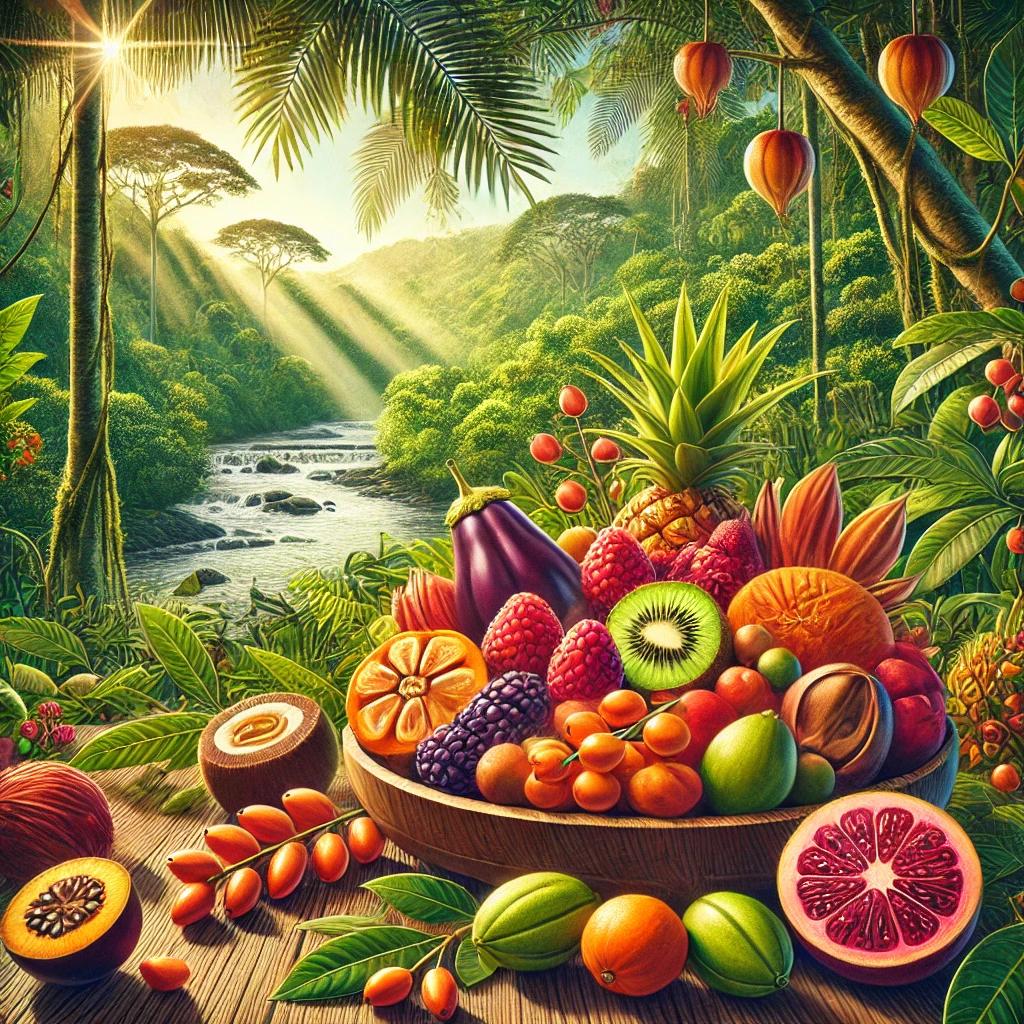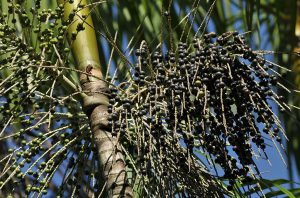Amazon Fruits, FOREVER THE FOREST
The Main Fruits of the Amazon: Exclusivity, Benefits, and Health Impact
The Main Fruits of the Amazon: Exclusivity, Benefits, and Health Impact
The Amazon is one of the richest biomes on the planet, hosting unique and exuberant biodiversity. Among its treasures are exclusive fruits that grow nowhere else in Brazil. These fruits possess nutritional and medicinal properties that benefit both humans and local animals. Below, we explore the main Amazonian fruits, their benefits, and their relationship with the ecosystem.
1. Camu-Camu (Myrciaria dubia)
Characteristics:
Native to the flooded areas of the Amazon, camu-camu is a small red or purple fruit, resembling a cherry, but extremely rich in vitamin C.
Benefits:
For humans:
- Strengthens the immune system.
- Combats premature aging due to its high antioxidant content.
- Helps prevent colds and flu.
- May improve mood by regulating serotonin levels.
For animals:
- Birds that eat camu-camu help disperse its seeds, contributing to forest regeneration.
Camu-camu has also gained attention in international markets as a superfood, used in powders and supplements for its potent health benefits.
2. Bacuri (Platonia insignis)
Characteristics:
A fruit with white, creamy, sweet-and-sour pulp, bacuri is native to the Amazon region and the state of Pará. It is encased in a thick, resistant shell.
Benefits:
For humans:
- Rich in phosphorus, calcium, and vitamin C, it strengthens bones and teeth.
- Has anti-inflammatory and healing properties.
- Improves digestion and helps combat constipation.
For animals:
- Animals like rodents feed on the pulp and help propagate the species by spreading its seeds.
Beyond its medicinal uses, bacuri is also a key ingredient in regional cuisine, used to prepare desserts, juices, and even ice creams.
3. Açaí de Taturubá (Euterpe precatoria)
Characteristics:
Unlike the common açaí (Euterpe oleracea), açaí de taturubá grows in more remote and wild areas of the forest. Its pulp is more concentrated and has a unique flavor.
Benefits:
For humans:
- Contains anthocyanins that fight free radicals and prevent cardiovascular diseases.
- A natural energy source, ideal for athletes and active individuals.
- Helps with brain health and memory.
For animals:
- Mammals like monkeys and sloths consume açaí de taturubá as a vital energy source.
As a rarer variety of açaí, its harvesting is closely tied to sustainable practices to ensure its preservation.
4. Cupuaçu (Theobroma grandiflorum)
Characteristics:
A close relative of cacao, cupuaçu has white, creamy pulp with an intense aroma. It is widely used in culinary and cosmetic applications.
Benefits:
For humans:
- Rich in polyphenols, it fights inflammation and promotes skin health.
- Improves mood and reduces stress due to its phytochemical compounds.
- Supports digestive health and strengthens the immune system.
For animals:
- Many Amazonian animals, such as coatis and capybaras, eat cupuaçu pulp, aiding in seed dispersal.
Cupuaçu butter, extracted from its seeds, is a popular ingredient in skincare products due to its hydrating properties.
5. Buriti (Mauritia flexuosa)
Characteristics:
Also known as the “tree of life” by Indigenous peoples, buriti is an orange fruit rich in oil and nutrients.
Benefits:
For humans:
- Excellent source of vitamin A, essential for eye and skin health.
- Contains antioxidants that protect against premature aging.
- Its oil is used to treat burns and wounds.
For animals:
- Consumed by macaws and other birds, which help maintain the ecosystem balance by dispersing seeds.
The oil extracted from buriti is also used in traditional remedies and as a natural sunscreen due to its protective properties.
6. Pupunha (Bactris gasipaes)
Characteristics:
A fruit that comes in yellow, red, or orange varieties, pupunha is highly nutritious and widely valued in Indigenous cuisine.
Benefits:
For humans:
- Rich in complex carbohydrates, providing sustainable energy.
- Contains fatty acids that help reduce bad cholesterol.
- Promotes hair and skin health due to its high vitamin E content.
For animals:
- Rodents and primates enjoy pupunha as an important energy source.
Pupunha is often boiled and served as a snack or used as an ingredient in dishes, showcasing its versatility in Amazonian gastronomy.
7. Tucumã (Astrocaryum aculeatum)
Characteristics:
A fruit with a bright orange skin and fibrous pulp, tucumã is typical of Amazonian palm trees.
Benefits:
For humans:
- Rich in essential fatty acids, it benefits heart health.
- Contains beta-carotene, important for vision and immune system support.
- An excellent energy source that also promotes skin health.
For animals:
- Many mammals, such as tapirs, consume tucumã and contribute to its natural cycle.
In regional cuisine, tucumã is a popular filling for sandwiches and pastries, adding a unique flavor and nutritional boost.
Ecological Importance of Amazonian Fruits
In addition to their direct benefits for humans and animals, these fruits play essential roles in maintaining the ecological balance of the Amazon. They provide food for various species and contribute to seed dispersal, aiding forest regeneration. For example:
- Birds and monkeys: Act as natural gardeners by eating the fruits and spreading seeds across large areas.
- Aquatic animals: Benefit from fruits that fall into rivers and streams, creating a vital food source.
Moreover, many Amazonian fruits hold cultural and spiritual significance for Indigenous populations, who use them in rituals and as natural remedies. These traditions emphasize the symbiotic relationship between humans and nature, highlighting the need for conservation.
Challenges and Conservation Efforts
Despite their importance, Amazonian fruits face threats from deforestation, climate change, and unsustainable harvesting practices. These activities disrupt ecosystems and endanger the species that depend on these fruits for survival.
Efforts to protect the Amazon include:
- Promoting sustainable harvesting methods.
- Supporting agroforestry projects that combine fruit cultivation with forest conservation.
- Raising awareness about the global importance of Amazonian biodiversity.
Local and international initiatives are crucial to ensuring that these fruits continue to thrive, benefiting both the environment and future generations.
The exclusive fruits of the Amazon not only showcase the region’s biological richness but are also a source of health and sustainability for humans and animals. Their preservation is essential to maintaining the ecosystem balance and valuing the ancestral knowledge of the Indigenous communities who inhabit the forest. Consuming them consciously and sustainably is a way to support the conservation of this unique natural heritage.
By appreciating and protecting Amazonian fruits, we contribute to the larger effort of preserving the Amazon rainforest—one of the most vital ecosystems on our planet. Let us honor the gifts of the Amazon by ensuring they remain a part of our world for generations to come.



